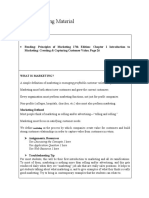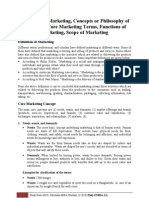Chapter One: St. Mary's University
Chapter One: St. Mary's University
Uploaded by
Gizachew NadewCopyright:
Available Formats
Chapter One: St. Mary's University
Chapter One: St. Mary's University
Uploaded by
Gizachew NadewOriginal Title
Copyright
Available Formats
Share this document
Did you find this document useful?
Is this content inappropriate?
Copyright:
Available Formats
Chapter One: St. Mary's University
Chapter One: St. Mary's University
Uploaded by
Gizachew NadewCopyright:
Available Formats
St.
Mary’s University
Chapter One
Introduction
Today’s successful companies have one thing in common: they are strongly customer
focused and heavily committed to marketing. These companies share a passion for
satisfying customer needs in well-defined target markets. They motivate everyone in the
organization to help build lasting customer relationships through superior customer value
and satisfaction.
Marketing more than any other business function, deals with customers. Although we
will soon explore more detailed definitions of marketing, perhaps the simplest definition
is this one:
Marketing is managing profitable customer relationships. The twofold goal of marketing
is to attract new customers by promising superior value and to keep and grow current
customers by delivering satisfaction.
1.1. MARKETING DEFINED
What is marketing? Many people think of marketing only as selling and advertising and
no wonder- everyday we are bombarded with television commercials, direct mail offers,
sales calls, and internet pitches. However selling and advertising are only the tip of the
marketing iceberg.
Today marketing must be understood not in the old sense of making a sale---“telling and
selling” – but in the new sense of “Satisfying customer needs”. If the marketer does a
good job of understanding consumer needs; develops products that provide superior
value; and prices, distributes, and promotes them effectively, these products will sell very
easily. Thus the selling and advertising are only part of a larger “ marketing mix” – a set
of marketing tools that work together to satisfy customer needs and build customer
relationships. Broadly defined marketing is a social; and managerial process by which
individuals and groups obtain what they need and want through creating and exchanging
value with others. In a narrow business context, marketing involves building profitable,
value-laden exchange relationships with customers. Hence, we define marketing as the
Department of Marketing Management 1
St. Mary’s University
process by which companies create value for customers and build strong customer
relationships in order to capture value from customers in return.
The Marketing Process
Figure 1.1 presents simple five-step model of the marketing process. In the first four
steps, companies work to understand consumers, create customer value, and build strong
customer relationships. In the final step, companies reap the rewards of creating superior
customer value. By creating value for customers, they in turn capture value from
consumers in the form of sales, profit, and long term customer equity.
Fig 1.1 A simple model of the Marketing process
Create value for customers and build customer relationship. Capture values from
customers increase
Understand the Design a customer Construct a Build profitable Capture value
marketplace and driven marketing marketing relationships’ and from customer to
customer needs strategy program that create customer create profits and
and wants delivers superior delight customer equity
value
1.2. UNDERSTANDING THE MAREKT PLACE AND CUSTOMER NEEDS
As a first step Marketers need to understand customer needs and wants and the market
place within which they operate. We now examine five core customer needs and wants
and the market place concepts: needs, wants, and demands; marketing offers; value and
satisfaction; exchange and relationships; and markets.
1. Customer Needs, Wants and Demands
The most basic concept underlying marketing is that of human needs. Human needs are
states of felt deprivation. They include basic physical needs for food, clothing, warmth,
and safety; social needs for belonging and affection; and individual needs for knowledge
and self expression. These needs were not created by marketers; they are a basic part of
the human make up.
Wants are the form human needs take as they are shaped by culture, and individual
personality. An Ethiopian needs food but wants ‘Injera’ with ‘Doro Wot’. Where as an
American needs food but want a Big Mac, French fries, and a soft drink. Wants are
Department of Marketing Management 2
St. Mary’s University
shaped by one’s society and are described in terms of objects that will satisfy needs.
When backed by buying power, wants become demands. Given their wants and
resources, people demand products with benefits that add up to the most value and
satisfaction.
Outstanding marketing companies go to great lengths to learn about and understand their
customers’ needs, wants and demands. They conduct consumer research and analyze
mountains of customer data. Their people at all level-including top management-stay
close to customers.
2. Marketing offers- products, Services and Experiences
Consumers’ needs and wants are fulfilled through marketing offers- some combination of
products services, information or experiences offered to market to satisfy a need or want.
Marketing offers are not limited to physical products. They also include services,
activities or benefits offered for sale that are essentially intangible and do not result in the
ownership of anything. Examples include banking, airline, hotel, tax preparation, and
home repair services. More broadly marketing offers also include other entities, such as
person, place, organization, information and ideas. Many sellers make the mistake of
paying more attention to the specific products they offer than to the benefits and
experiences produced by these products. These sellers suffer from “Marketing Myopia”.
They are so taken with their products that they focus only on existing wants and lose
sight of underlying customer needs. They forget that a product is only a tool to solve a
consumer problem. A manufacturer of drill bits may think that the consumer needs is a
hole. These sellers will have a trouble if anew product comes along that serves the
customer’s need better or less expensively. The customer will have the same need but
will want the new product.
3. Customer value and satisfaction
Customers usually face a broad array of products and services that might satisfy a given
need. How do they choose among these many marketing offers? Customers’ value refers
to the customer’s evaluation of the difference between all the benefits and all the costs of
a marketing offer relative to those of competing offers. In other words we can define
value as the ratio between what the customer gets and what he/she gives. The benefit
Department of Marketing Management 3
St. Mary’s University
includes functional benefits and emotional benefits. The cost includes monetary costs,
time costs and energy costs. Customers form expectations about the value and
satisfaction that various marketing offers will deliver and buy accordingly.
Customer satisfaction is the extent to which a product perceived performance matches a
buyer’s expectation. If the products performance falls short of expectations the customer
is dissatisfied. If performance matches expectations, the customer is satisfied. If
performance exceeds expectations, the customer is highly satisfied or delighted. Satisfied
customers buy again and tell others about their good experience. Dissatisfied customers
often switch to competitors and disparage the product to others.
Marketers must be careful to set the right level of expectations. If they set expectations
too low, they may satisfy those who buy but fail to attract enough buyers. If they raise
expectations too high, buyers will be disappointed. Customer value and customer
satisfaction are key building rocks for developing and managing customer relationships.
4. Exchanges and Relationships
Marketing occurs when people decide to satisfy needs and wants through exchange
relationships. Exchange is the act of obtaining a desired object from someone by offering
something in return. In the broadest sense, the marketer tries to bring about a response to
some marketing offer. The response may be more than simply buying or trading products
and services. A political candidate, for instance, wants votes a church wants membership,
and a social action group wants idea acceptance.
For exchange potential to exist, five conditions must be satisfied:
1. There are at least two parties
2. Each party has something that might be of value to the other party
3. Each party is capable of communication and delivery.
4. Each party is free to accept or reject the exchange offer.
5. Each party believes it is appropriate or desirable to deal with the other party.
Marketing consists of actions taken to build and maintain desirable exchange
relationships with target audiences involving a product, service, idea or other object.
Department of Marketing Management 4
St. Mary’s University
Beyond simply attracting new customers and creating transactions, the goal is to retain
customers and grow their business with the company. Marketers want to build strong
relationship by consistently delivering superior customer value.
5. Markets
The concept of exchange and relationships lead to the concept of market. A market is the
set of actual and potential buyers of a product. These buyers share a particular need and
want that can be satisfied through exchange relationships.
Marketing means managing markets to bring about profitable customer relationships.
However, creating these relationships takes work. Sellers must search for buyers,
identify their needs, design good marketing offers, set prices for them, promote them and
store and deliver them. Activities such as product development, research, communication,
distribution, pricing and services are core marketing activities.
Although we normally think of marketing as being carried on by sellers, buyers also carry
on marketing. Consumers do marketing when they search for the goods they need at the
price they can afforded. Company purchasing agents do marketing when they track down
sellers and bargain for goods terms.
Figure 1.2 illustrates the main elements in a modern marketing system. In the usual
situation, marketing involves serving a market of final consumers in the face of
competitors. The company and the competitors send their respective offers and messages
to consumers, either directly or through marketing intermediaries. All of the actors in the
system are affected by major environmental forces (demographic, economic, physical,
technological, political/ legal, and social/cultural).
Each party in the system adds value for the next level. All of the arrows represent
relationships that must be developed and managed. Thus, a company’s success at
building profitable relationships depends not only on its own actions but also on how well
the entire system serves the needs of final consumers.
Department of Marketing Management 5
St. Mary’s University
Fig 1.2 Elements of a Modern marketing System
Environment
1.3 DESIGNING A CUSTOMER–DRIVEN MARKETING STRATEGY
Once it fully understands consumers and the marketplace, marketing management can
design a customer driven marketing strategy. We define marketing management as the
art and science of choosing target markets and building profitable relationships with
them. The marketing manager’s aim is to find, attract, keep and grow target customers
by creating, delivering, and communicating superior customer value.
To design a winning marketing strategy, the marketing manager must answer two
important questions: What customers will we serve (what is our target market)? And
how can we serve the customers best (what is our value proposition) A company’s value
preposition is the set of benefits or values it promises to deliver to consumers to satisfy
their needs.
Individuals may think of marketing management as finding enough customers for
company’s current output but this view is too limited. Any organization has a desired
level of demand for its products. At any point in time, there may be no demand, adequate
demand, irregular demand or too much demand and marketing management must find
ways to deal with these different demand states. Marketing management is concerned not
only with finding and increasing demand, but also with changing or even reducing it.
1. Negative Demand- A market is in a state of negative demand if a major part of the
market dislikes the product and may even pay a price to avoid it. Some people have
negative demand for vaccination and in some situation they even pay a higher price to
replace it by tablets or some other form of treatment. The marketing task is to analyze
Department of Marketing Management 6
St. Mary’s University
why the market dislikes the product and whether a marketing program consisting of
product redesign, lower prices, and more positive promotion can change the market’s
beliefs and attitudes these marketing task/ activity is known as “ conversional
marketing”.
2. No Demand- Target consumers may be unaware of or uninterested in the product or
services. Thus, farmers may not be interested in a new farming method, and college
students may not be interested in foreign language courses. The marketing task is known
as “stimulational marketing”; its task is to find ways to connect the benefits of the
product with the person’s natural needs and interests.
3. Latent Demand- Many consumers may share a strong need that cannot be satisfied
by any existing actual product. There is a strong latent demand for harmless cigarettes
and HIV/AIDS medicine. The marketing task is called; “developmental marketing” its
main task is to measure the size of the potential market and develop effective goods and
services that would satisfy the demand.
4. Declining/ falling Demand- Every organization, sooner or later, faces declining
demand for one or more of its products. The marketer must analyze the causes of market
decline and determine whether demand can be restimulated by finding new target
markets, changing the product’s features or developing more effective communication.
The marketing task is, “remarketing” to reverse the declining demand through creative
remarketing of the product.
5. Irregular Demand— Many organizations- face demand that varies on a seasonal,
daily, or even hourly basis, causing problems of idle or overworked capacity. Museums
are under visited on weekdays and overcrowded on weekends. Hotels, restaurants,
recreational areas are also overworked in weekends and some specific hours and less
attended on others. The marketing task, which is called ‘synchromarketing’, is to find
ways to alter the same pattern of demand through flexible pricing, promotion, and other
incentives.
6. Full Demand- Organizations face full demand when they are pleased with their
volume of business. “Maintenance marketing” is the marketing task, which designs to
maintain the current level of demand in the face of changing consumer preferences and
Department of Marketing Management 7
St. Mary’s University
increasing competition. The organization must maintain or improve its quality and
continually measure consumer satisfaction to make sure it is doing a good job.
7. Overfull Demand— In some situations, organizations face a demand level that is
higher than what they can or want to handle. The marketing task, which is called
“demarketing”, it requires finding ways to reduce demand temporarily or permanently.
Demarketing seeks to discourage overall demand and consists of such steps as raising
prices and reducing promotion and service. Demarketing aims not to destroy demand but
also to reduce its level, temporarily or permanently.
8. Unwholesome Demand- It is the demand for unhealthy products like cigarette,
alcohol, hard drugs, handguns, and X-rated movies. Unwholesome products will attract
organized efforts to discourage their consumption. The marketing task is to get people
who like something to give it up, using such tools as fear massage, price hikes, and
reduced availability. The corresponding marketing task is known as “counter marketing”.
Marketing Management Orientations
Marketing management wants to design strategies that will build profitable relationships
with target consumers. But what philosophy should guide these marketing strategies?
What weight should be given to the interest of customers, the organization and society?
Very often, these interests conflict.
There are five alternative concepts under which organizations design and carry out their
marketing strategies: the production, product, selling, marketing and societal marketing
concepts.
1. The Production Concept
The production concept holds that consumers will favor products that are available and
highly affordable. Therefore, management should focus on improving production and
distribution efficiency. This concept is one of the oldest orientations that guides sellers.
The production concept is still a useful philosophy in two types of situation. The first
occurs when the demand for a product exceeds the supply. Here, managements should
look for ways to increase production. The second situation occurs when the product’s
cost is too high and improved productivity is needed to bring it down.
Department of Marketing Management 8
St. Mary’s University
Although useful in some situations. The production concept can lead to marketing
mayopia. Companies adopting this orientation run a major risk of focusing too narrowly
on their own operations and losing sight of the real objective-satisfying customer need
and building customer relationships.
2. The Product Concept
The product concept holds that consumers will favor products that offer the most in
quality, performance, and innovation features. Under this concept marketing strategy
focuses on making continuous product improvement. Some manufacturers believe that if
they can build a better mouse-trap, the world will beat a path to their door. But they are
often rudely shocked. Buyers may well be looking for a better solution to a mouse
problem but not necessarily for a better mousetrap. The solution might be a chemical
spray, an exterminating service, or something that works better than mousetrap.
Furthermore a better mousetrap will not sell unless the manufacturer designs, packages,
and price it attractively; place it in convenient distribution channels; brings it to the
attention of people who need it; and convinces buyers that it is better product. Thus, the
product concept also can lead to marketing myopia.
3. The Selling Concept
Many companies follow the selling concept, which holds that consumers will not buy
enough of the firms products unless it under takes a large-scale selling and promotion
effort. The concept is typically practiced with unsought goods- those that buyers do not
normally think of buying, such as insurance or blood donations. These industries must be
good at tracking down prospects and selling them on product benefits.
Most firms practice the selling concept when they face overcapacity. Their aim is to sell
what they make rather than make what the market wants. Such a marketing strategy
carries high risks. It focuses on creating sales transactions rather than on building long-
term profitable customer relationships.
4. The Marketing Concept
The marketing concept holds that achieving organizational goals depends on knowing the
needs and wants of target markets and delivering the desired satisfactions better than
Department of Marketing Management 9
St. Mary’s University
competitors do. Under this concept, customer focus and value are the paths to sales and
profit.
Instead of a product centered “market and sell” philosophy, the marketing concept is a
customer-centered “sense and respond” philosophy. It views marketing not as ‘hunting’
but as ‘gardening’. The job is not to find the right customer for your product but to find
the right product for your customer. Figure 1.3 contrasts the selling concept and the
marketing concept. The selling concept takes an “inside-out” perspective, whereas, the
marketing concept takes an “outside- in” perspective.
Fig. 1.3. The selling and marketing concepts contrasted
5. The Societal Marketing Concept
The societal marketing concept questions whether the pure marketing concept overlooks
possible conflicts between consumers’ short-run wants and consumer long-run welfare. Is
a firm that satisfies the immediate needs and wants of a target markets always doing what
is best for consumers in the long run? The societal marketing concept holds that
marketing strategy should deliver value to customers in a way that maintains or improves
both the consumer’s and the society’s well –being.
Department of Marketing Management 10
St. Mary’s University
As the figure 1.4 shows, companies should balance there considerations in setting their
marketing strategies: company profits, consumer wants, and society’s interests.
Fig. 1.4. Three considerations underlying the societal marketing concept
1.4. Preparing a Marketing plan and program
The company’s marketing strategy outlines which customers the company will serve and
how it will create value for these customers. Next, the marketer constructs a marketing
program that will actually deliver the intended value to target customers. The marketing
program builds customer relationships by transforming the marketing strategy into action.
It consists of the firms marketing mix, the set of marketing tools the firm uses to
implement its marketing strategy.
The major marketing mix tools are classified into four broad groups, called the four P’s
of marketing: product, Price, Place and promotion. To deliver on its value proposition the
firm must firs create a need-satisfying marketing offer (product). It must decide how
much it will charge for the offer (price). And how it will make the offer available to
target customers (place). Finally, it must communicate with target customers about the
offer and persuade them of its merits (promotion).
1.5. Building Customer Relationship
The first three steps in the marketing process lead up to the fourth and most important
step: building customer relationships.
Department of Marketing Management 11
St. Mary’s University
Customer relationship management (CRM) is perhaps the most important concept of
modern marketing. Until recently, CRM had been defined narrowly as a customer data
management activity. By this definition, it involves managing detailed information about
individual customers and carefully managing customer touch points in order to maximize
customer loyalty.
More recently, however, CRM has taken on a broader meaning. In this broader sense, it is
the overall process of building and maintaining profitable customer relationships by
delivering superior customer value and satisfaction. It deals with all aspects of acquiring,
keeping and growing customers.
1.6 Capturing Value from Customers
The first four steps in marketing process involve building customer relationships by
creating and delivering superior customer value. The final step involves capturing value
in return, in the form of current and future sales, market share, and profits. By creating
superior customer value, the firm creates highly satisfied customers who stay loyal and
buy more. This, in turn, means greater long-run returns for the firm. It deals with the
outcome of creating customer value: customer loyalty and retention, share of market and
share of customer, and customer equity.
1.7 The New Marketing Landscape
As the world spins into the first decade of the twenty- first century, dramatic changes are
occurring in the market-place. In this section, we examine the major trends and forces
that are changing the marketing landscape and challenging marketing strategy. We look
at four major developments: the new digital age, rapid globalization, the call for more
ethics, and social responsibility, and the growth in not-for –profit marketing.
1. The New Digital Age
The recent technology boom has created a new digital age. The explosive growth in
computer, telecommunications, information, transportation, and other technologies has
had a major impact on the ways companies bring value to their customers.
The technology boom has created existing new ways to learn about and track customers,
and to create products and services tailored to individual customer needs. Technology is
Department of Marketing Management 12
St. Mary’s University
also helping companies to distribute products more efficiently and effectively. And it’s
helping them to communicate with customers in large groups or one to one.
Through videoconferencing, marketing researchers at company’s headquarters can look
in on focus groups in some other location without ever stepping in a plane. With only a
few clicks of a mouth button, a direct marketer can tap into online data services to learn
anything from what car you drive to what flavor of ice cream you prefer.
Technology has also brought a new wave of communication and advertising tools-
ranging from cell phones, fax machines, CD-ROM, and interactive TV to video kiosks at
airports and shopping malls. Through E-commerce, customers can learn about, design,
order, and pay for products and services- without ever leaving home. Then, through the
marvels of express delivery, they can receive their purchases in less than 24 hours.
Perhaps the most dramatic new technology is the Internet. Today the internet links
individuals and business of all types of each other and to information all around the
world. It allows anytime, anywhere connections to information, entertainment, and
communication. Companies are using the internet to build closer relationships with
customers and marketing partners.
2. Rapid Globalization
As they are redefining their relationships with customers and partners, marketers are also
taking a fresh look at the ways in which they connect with the broader world around
them. In an increasingly smaller world, many marketers are now connected globally with
their customers and marketing partners.
Today, almost every company, large or small, is touched in some way by global
competition. Today, companies are not only trying to sell more of their locally produced
goods in international market, they also are buying more supplies and components
abroad. Thus managers in countries around the world are increasingly taking a global, not
just local, view of the company’s industry, competitors and opportunities. They are
asking: what is global marketing? How does it differ from domestic marketing? How do
global competitors and forces affect our business? To what extent should we go global?
Department of Marketing Management 13
St. Mary’s University
3. The Call for More Ethical and Social Responsibility
Marketers are reexamining their relationships with social values and responsibilities and
with the very Earth that sustain us. As the world wide consumerism is and
environmentalism movements mature, today’s marketers are being called upon to take
greater responsibility for the social and environmental impact of their actions. Corporate
ethics and social responsibility have become hot topics for almost every business. And
few companies can ignore the renewed and very demanding environmental movement.
The social- responsibility and environmental movements will place even stricter demands
on companies in the future. Some companies resist these movements, budging only when
forced by legislation or organized consumer outcries. More forward looking companies,
however readily accept their responsibility to the world around them. They view socially
responsible actions as an opportunity to do well by doing good. They seek ways to profit
by serving the best long-run interests of their customers and communities.
4. The Growth of Not –for-Profit Marketing
In the past marketing has been most widely applied in the for-profit business sector. In
recent years, however, marketing also has become a major part of the strategies of many
not-for-profit organizations, such as colleges, hospitals museums etc. Government
agencies have also shown an increased interest in marketing.
Department of Marketing Management 14
You might also like
- Accounting Cycle Project 3 Financial Accounting Fundamentals PDFDocument9 pagesAccounting Cycle Project 3 Financial Accounting Fundamentals PDFGinger Fox0% (1)
- Financial Accounting Formulas and NotesDocument10 pagesFinancial Accounting Formulas and NotesAntonio LinNo ratings yet
- LG ElectronicsDocument21 pagesLG ElectronicsAbhinava Chanda0% (2)
- Royce Chocolate Marketing Plan1Document24 pagesRoyce Chocolate Marketing Plan1justme310963% (8)
- Unit1 MCQ OnlyDocument112 pagesUnit1 MCQ OnlyAldrin Santos AntonioNo ratings yet
- Marketing Summary Chapter 1Document8 pagesMarketing Summary Chapter 1hamanNo ratings yet
- CH 07 DOitDocument4 pagesCH 07 DOitHanna DizonNo ratings yet
- 09 How Low Can It GoDocument3 pages09 How Low Can It GoHéctor Eduardo Moreno Sandoval75% (4)
- Chapter One: St. Mary S UniversityDocument8 pagesChapter One: St. Mary S UniversitySudeisy GeresuNo ratings yet
- Chapter 1. Marketing Creating and Capturing Customer ValueDocument6 pagesChapter 1. Marketing Creating and Capturing Customer ValueAnna PanteNo ratings yet
- Local Media6237896398194248818 013748Document10 pagesLocal Media6237896398194248818 013748Kaye PauleNo ratings yet
- 2021chapter 1 MarketingDocument48 pages2021chapter 1 MarketingAptHouL AzizNo ratings yet
- Marketing Module 1Document9 pagesMarketing Module 1Iphone PicturesNo ratings yet
- Introduction To MarketingDocument8 pagesIntroduction To MarketingchstuNo ratings yet
- Chapter 1 (Marketing Updated)Document9 pagesChapter 1 (Marketing Updated)i211416 Shizza KianiNo ratings yet
- Kotler Pom16e Inppt 01 PDFDocument58 pagesKotler Pom16e Inppt 01 PDFNashran Harith NazreeNo ratings yet
- 1 - Marketing and Its Core ConceptsDocument77 pages1 - Marketing and Its Core Conceptspreethi g krishnan75% (4)
- Chapter 1: Marketing - Creating Customer Value and EngagementDocument12 pagesChapter 1: Marketing - Creating Customer Value and EngagementT.Thomas100% (1)
- L1 - Introduction To Marketing ManagementDocument10 pagesL1 - Introduction To Marketing ManagementPrincess Lyka Mae PalomarNo ratings yet
- 1 - Marketing and Its Core ConceptsDocument78 pages1 - Marketing and Its Core ConceptsBhavana ModiyilNo ratings yet
- Marketing PowerPoint PresentationDocument29 pagesMarketing PowerPoint PresentationnatinaelNo ratings yet
- Principles of Marketing Chapter1 NoteDocument5 pagesPrinciples of Marketing Chapter1 NoteQuazi Mahbub Hassan100% (3)
- The Marketing ProcessDocument6 pagesThe Marketing Processogenrwotronald10No ratings yet
- MARKETING Chap 1 NotesDocument9 pagesMARKETING Chap 1 Notesrubaa sivakumarNo ratings yet
- Week 1 Learning Material: Key ConceptsDocument8 pagesWeek 1 Learning Material: Key Conceptshajra ubaidNo ratings yet
- Markting 1Document11 pagesMarkting 1History and EventNo ratings yet
- Principle of Marketing CHAPTER 1Document10 pagesPrinciple of Marketing CHAPTER 1Alemayehu gabisaNo ratings yet
- Chapter - 1 - Creating - and - Capturing - Customer - Value - ELDocument45 pagesChapter - 1 - Creating - and - Capturing - Customer - Value - ELMaya Dana100% (1)
- Saeed Radhi What Is Marketing ?Document4 pagesSaeed Radhi What Is Marketing ?esjay19No ratings yet
- Chapter One Managing Profitable Customer Relationship: What Is Marketing?Document17 pagesChapter One Managing Profitable Customer Relationship: What Is Marketing?hesham hassanNo ratings yet
- Chapter 1 Managing Profitable Customer RelationshipsDocument13 pagesChapter 1 Managing Profitable Customer Relationshipswhateveroil100% (1)
- An Overview of Marketing in The Hospitality Industry 1Document4 pagesAn Overview of Marketing in The Hospitality Industry 1Angela UrbiztondoNo ratings yet
- Principle of Marketing (Chapter 1)Document14 pagesPrinciple of Marketing (Chapter 1)adamu shumetNo ratings yet
- Marketing CH 1Document7 pagesMarketing CH 1Antu SaymaNo ratings yet
- Chapter One: 1.1. Marketing and Its Core Concepts What Is Marketing?Document11 pagesChapter One: 1.1. Marketing and Its Core Concepts What Is Marketing?SARA JUHARNo ratings yet
- Chapter One Overview of Principles of MarketingDocument17 pagesChapter One Overview of Principles of Marketingfikiruabera18No ratings yet
- Raya University Department of Management Chapter One 1.1. Marketing and Its Core ConceptsDocument11 pagesRaya University Department of Management Chapter One 1.1. Marketing and Its Core Conceptsyared haftuNo ratings yet
- Marketing Chapter 1Document46 pagesMarketing Chapter 1Torifur Rahman BiplobNo ratings yet
- MBA Comprehensive Exam Marketing ManagementDocument6 pagesMBA Comprehensive Exam Marketing ManagementguevarramilanyNo ratings yet
- PMK SumDocument59 pagesPMK SumNgan DinhNo ratings yet
- Marketing Concepts and Internal Relations: CD Anh Quoc Btec FPT International EconomyDocument8 pagesMarketing Concepts and Internal Relations: CD Anh Quoc Btec FPT International EconomyHuyền TrangNo ratings yet
- Marketing-Class Note 1Document15 pagesMarketing-Class Note 1Mohd. Golam Mostafa100% (1)
- Chapter 1-3 Review Notes MGN 2210Document8 pagesChapter 1-3 Review Notes MGN 2210KaiNo ratings yet
- Week 1 - Marketing, Creating Customer ValueDocument3 pagesWeek 1 - Marketing, Creating Customer ValueMaureen Kristianne VillavertNo ratings yet
- Introduction To Marketing Hand OutDocument7 pagesIntroduction To Marketing Hand Outhalasoofi26No ratings yet
- AEng 5208-CH-IDocument13 pagesAEng 5208-CH-INigatu BantiNo ratings yet
- Draft Asm1 5033Document10 pagesDraft Asm1 5033Nguyễn NhiNo ratings yet
- Principles of MarketingDocument224 pagesPrinciples of Marketingmelkamu endaleNo ratings yet
- Marketing Management U 1Document27 pagesMarketing Management U 1Sana KhursheedNo ratings yet
- Chapter 1Document12 pagesChapter 1alemayehuNo ratings yet
- Understanding The Marketplace and Customer NeedsDocument6 pagesUnderstanding The Marketplace and Customer NeedsTesfaye BelayeNo ratings yet
- MarketingDocument2 pagesMarketingasad0310370No ratings yet
- Chapter One Overview of Principles of MarketingDocument11 pagesChapter One Overview of Principles of Marketingnewaybeyene5No ratings yet
- Principle of Marketing and Consumer BehaviorDocument100 pagesPrinciple of Marketing and Consumer BehaviorAddaa WondimeNo ratings yet
- PM CH1Document49 pagesPM CH1rana hijjawiNo ratings yet
- Manajemen PemasaranDocument2 pagesManajemen PemasarantessafikriNo ratings yet
- Module 1 (MM)Document25 pagesModule 1 (MM)Manasa P MNo ratings yet
- CH1 PrincipleDocument34 pagesCH1 PrincipleBelay AdamuNo ratings yet
- PM2 - The Marketing ProcessDocument41 pagesPM2 - The Marketing ProcessRHam VariasNo ratings yet
- Principles of MarketingDocument38 pagesPrinciples of MarketingZaki Sarfraz50% (2)
- CH 1 Define MarketingDocument38 pagesCH 1 Define MarketingCave BosNo ratings yet
- MarketingDocument58 pagesMarketingUsman ManiNo ratings yet
- The Secret Journey of Marketing: Unveiling the Magical Secrets of Marketing World for Beginners. A Complete Guide to the Marketing Universe.From EverandThe Secret Journey of Marketing: Unveiling the Magical Secrets of Marketing World for Beginners. A Complete Guide to the Marketing Universe.No ratings yet
- Guerrilla Marketing Excellence (Review and Analysis of Levinson's Book)From EverandGuerrilla Marketing Excellence (Review and Analysis of Levinson's Book)No ratings yet
- The Entrepreneur's Toolkit: Time Management, Networking, and More for New BuisnessFrom EverandThe Entrepreneur's Toolkit: Time Management, Networking, and More for New BuisnessNo ratings yet
- OM Chapter 3-6Document114 pagesOM Chapter 3-6Gizachew NadewNo ratings yet
- Business EthicsDocument20 pagesBusiness EthicsGizachew NadewNo ratings yet
- CoffeeDocument5 pagesCoffeeGizachew NadewNo ratings yet
- Chapter 3 Accounting For AgricultureDocument60 pagesChapter 3 Accounting For AgricultureGizachew Nadew100% (2)
- Final Chapter 6Document14 pagesFinal Chapter 6Gizachew NadewNo ratings yet
- Poultry Farm Business PlanDocument20 pagesPoultry Farm Business PlanGizachew NadewNo ratings yet
- Prin CH 4 - 6Document18 pagesPrin CH 4 - 6Gizachew NadewNo ratings yet
- Stat 1-3 ChaptersDocument36 pagesStat 1-3 ChaptersGizachew NadewNo ratings yet
- Stat 4-6 ChapterDocument37 pagesStat 4-6 ChapterGizachew NadewNo ratings yet
- Components of Indian Financial SystemDocument10 pagesComponents of Indian Financial Systemvikas1only100% (2)
- 1.2.3 Line and Staff FunctionsDocument4 pages1.2.3 Line and Staff FunctionsPrashant100% (1)
- GhjgyuiytuytDocument4 pagesGhjgyuiytuytLorelyn TriciaNo ratings yet
- Karoora Hojii Damee Leenjii - Final)Document19 pagesKaroora Hojii Damee Leenjii - Final)Kenanisa Polytechnic College-AsellaNo ratings yet
- 2.1 Industry Profile: Mutual FundDocument16 pages2.1 Industry Profile: Mutual FundAbdulRahman ElhamNo ratings yet
- Cbme - Midterm-Examination-Reviewer EditedDocument7 pagesCbme - Midterm-Examination-Reviewer EditedGemini LibraNo ratings yet
- QUIZ Capital BudgetingDocument4 pagesQUIZ Capital BudgetingMalik Saif AminodenNo ratings yet
- Assignment 1-Winter2024-Ch-Cost and Job Order QuestionDocument6 pagesAssignment 1-Winter2024-Ch-Cost and Job Order Questionstudent.devyankgosainNo ratings yet
- Background Study FASHION INDUSTRY IN INDIA - AN OVERVIEWDocument20 pagesBackground Study FASHION INDUSTRY IN INDIA - AN OVERVIEWOFC accountNo ratings yet
- ROLE OF STARTUPS IN ENTREPRENEURIAL DEVELOPMENT IN KERALA Ijariie11821Document7 pagesROLE OF STARTUPS IN ENTREPRENEURIAL DEVELOPMENT IN KERALA Ijariie11821AswinNo ratings yet
- Customer Relationship Management Research Paper PDFDocument5 pagesCustomer Relationship Management Research Paper PDFaypewibkfNo ratings yet
- Nutella Case Study (English)Document1 pageNutella Case Study (English)Adnan KhanNo ratings yet
- Ariel PresentationDocument19 pagesAriel PresentationBhavin VadhadiyaNo ratings yet
- Production and Cost AnalysisDocument140 pagesProduction and Cost AnalysisSiddharth MohapatraNo ratings yet
- Introduction To Financial MarketsDocument28 pagesIntroduction To Financial MarketsUttam Gaurav100% (2)
- Monopolistic Competition (Handout)Document19 pagesMonopolistic Competition (Handout)ALYSSA TOHNo ratings yet
- Goodwill and Human Capital ValuationDocument2 pagesGoodwill and Human Capital ValuationTekebaNo ratings yet
- BUS 5112 Discussion Assignment Unit 2Document2 pagesBUS 5112 Discussion Assignment Unit 2Raju SobhanNo ratings yet
- 6290 - 60887 - Proposal Magang Bca Revisi 2Document17 pages6290 - 60887 - Proposal Magang Bca Revisi 2Ahmad Rifqi RomadhaniNo ratings yet
- CHAPTER 5 Sales ManagementDocument50 pagesCHAPTER 5 Sales ManagementFelicia TangNo ratings yet
- Production and Operations Management: Jonathan MolaroDocument227 pagesProduction and Operations Management: Jonathan Molarosampada.khopadeNo ratings yet
- Use Financial Terms To Get Management To Take Notice of Your Quality MessageDocument12 pagesUse Financial Terms To Get Management To Take Notice of Your Quality MessageAnahii KampanithaNo ratings yet
- MM1 Assignment 16-18 Group7Document8 pagesMM1 Assignment 16-18 Group7Prateek SinghaniaNo ratings yet


































































































